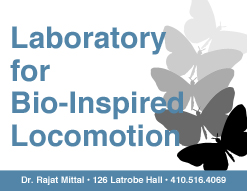objective
Insects such as butterflies excel in performing highly complex flight maneuvers. The objective of this project is to gain insight into the aerial maneuvers of Painted Lady butterflies. The primary focus of this project is to understand the extent to which insects facilitate maneuvering by actively changing their moment of inertia characteristics. High-speed, high-resolution videogrammetry is used to quantify the trajectory and body conformation of these insects during flight maneuvers. In addition, measurements of the mass properties of the insect are made and used to parameterize a simple flight dynamics model of the butterfly. These measurements and this analysis allow us to determine the role of active inertia change in various flight maneuvers.
motivation
Micro-aerial vehicles (MAV) are being designed for a variety of missions including environmental monitoring, search-and-rescue, and reconnaissance. In developing these MAVs, there is much that can be learnt from insects because evolution has created an incredible variety of flying insects that have successfully colonized almost all known terrestrial habitats. One area where MAVs are lacking is maneuverability. The established method of studying the maneuverability of insects is to analyze the aerodynamic forces produced by the insect via flow visualization. Instead of directly exploring the aerodynamic forces at play, this project will focus on how insects such as butterflies actively use body and wing deformation to change their moment of inertia characteristics and facilitate maneuvers from a kinematic perspective. In the near term, we expect to answer some fundamental questions regarding the dynamics of insect flight maneuvers; in the long term, this project could benefit MAV design.
